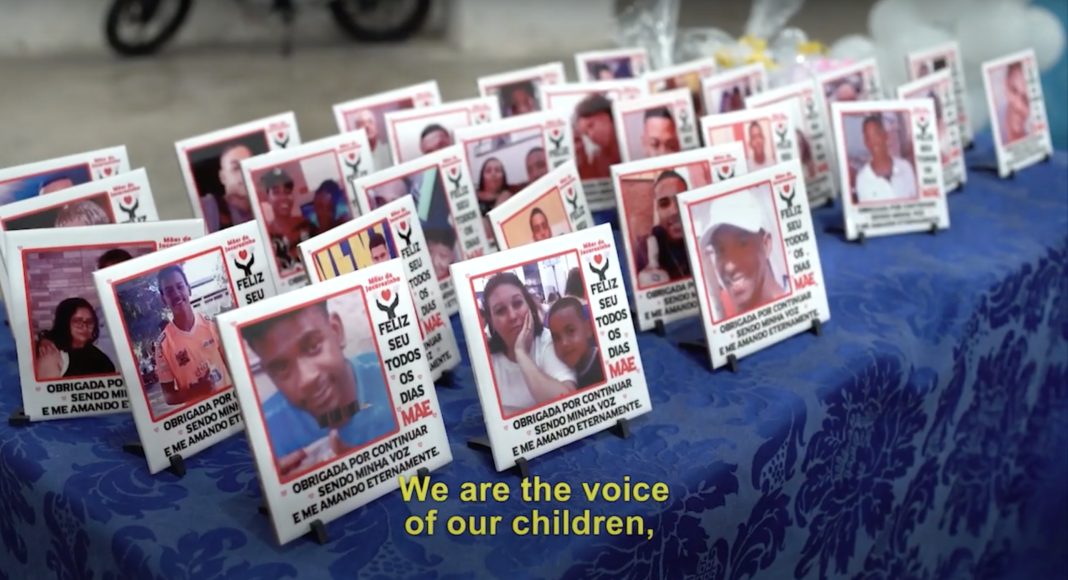- The documentary ‘Orphan Mothers’ premiered on 30 June at Kings College London (KCL). The documentary is the fruit of an idea born in the minds of Director Patrick Granja and musician MC Leonardo; and was produced by community activists in Rio de Janeiro with support from KCL’s Transnational Law Institute.
- The screening was preceded by a Capoeria Roda performance, which included music by composer Carlo Alexandre which appeared in the film.
- It was followed by an in-person Q&A with the Director, Patrick Granja, MC Leonardo, and mothers Ana Paula Gomes de Oliveira, whose son Jonathan was fatally shot at 19 years old by the pacifying police unit, and Irone Maria Santiago whose 35 year old son, musician Vitor Santiago Borges, also in attendance, is now disabled as a result of a police shooting.
- Ana Paula is part of the campaigning organization Mães de Manginhos (Mothers of Manguinhos) and Irone is a campaigner of Redes da Maré (Networks of Maré). The mothers and Vitor feature prominently in the film.
- Ana Paula was interviewed in LAB’s 2019 book Voices of Latin America.
- Redes da Maré and their transformative Women’s House featured in LAB and KCL’s collaboratively produced podcast Women Resisting Violence (episode 3).
There is a term for a child whose parents have died: an orphan. But there is currently no such term for a parent whose child has died. How can this be, when Brazilian police have killed 33,000 people, mostly Black men, in the last decade alone, producing masses of traumatized parents? Enter Orphan Mothers, which explores this paradox in graphic and granular detail by staying firmly rooted in the favelas of Rio de Janeiro.
Orphan Mothers is a powerful intervention, and the star of the show is the raw unfiltered footage from within the favelas that at once forces you to contend with the absolute lethality of the state and admire the fortitude of the mothers and favela communities at large. The soundtrack is truly exceptional, enhancing the emotional intensity of the hard-hitting material and of the viewing experience.
Targeting the favelas
Romantic, swooping panoramic vistas of Rio de Janeiro, otherwise known as the ‘Marvellous City’, stun and beguile. However, the artful aerial views of the curving mountains, gleaming coastline, and mosaic-like stacked houses, belie the violent reality on the ground where the state takes aim at the city’s favelas.
Although in practice it describes groups of neighbourhoods, the term ‘favela’ is often used by outsiders as a synonym for ‘shanty-town’ to denote the physical make-shift nature of the housing materials, and as a pejorative term akin to ‘ghetto’. But the social history of these settlements is far more illuminating that the term itself would imply and is crucial for understanding the contemporary Brazilian reality of anti-Black police terror.
‘Favelas are not criminal – they are criminalized and marginalized by society’.
The genesis of favelas can be traced back to the late 19th century, when impoverished former enslaved people formed settlements on the outskirts of the city. Yet, it was primarily the great wave of migration of poor rural migrants to the cities during the 1940s and 1970s that gave rise to the proliferation of favelas.
Despite successive, aggressive state policies of favela eradication, the settlements have continued to sprawl all around the metropolises of the country, with marginalized Black people concentrated into these zones. Into the early 1980s, the country became an important global centre in the illicit trade of drugs, and drug violence and police brutality escalated within favelas.
In the present day, the favela ‘as a Black spatiality’ has been conceptualized by outsiders as ‘a signifier of violence, crime and disorder’ with ‘its residents cast as a permanent threat to urban life’.
The UPPs in action
This dominant depiction of the favela became the pretext for the state to launch in 2008, ahead of the 2014 World Cup and 2016 Olympic Games, the Pacifying Police Units program, (Unidades de Polícia Pacificadora – UPP), a partnership between the State Security and the military police which has the purported aim of ‘reclaim[ing] the city’s favelas from [the] gangs’. Under the guise of pacification, the police have occupied many of the city’s largest favelas. More broadly, the construction of favelas as a hotbed of Black criminality has legitimized the pacifying police unit, the military, the military police, and the civilian police to invade and inflict violence and death on its inhabitants.

‘Orphan Mothers’ confronts us with handheld clandestine imagery shot inside the favelas of Rio de Janeiro: waves of military tanks conquering the streets; helicopters looming ominously; officers clutching rifles atop military jeeps; and helmeted, bullet-proof vested police lining up along the walls.
The no-frills footage is a sonic and visual assault on the senses – gunfire erupts, hand grenades blind the screen white, and people scream in terror. These scenes repeat incessantly across the various favelas of Rio, including Complexo do Alemão, Rocinha, and Jacarezinho.
These scenes, almost carbon-copies of one another, reinforce the point that anti-Black state violence 1)Anti-Black is a term used to describe a specific type of racism directed at Black people. is not merely something that happens in the favelas, but rather, that it is a condition of the favelas.
As one expert interviewed for the film explains, though military occupations are usually temporary measures in times of war or conflict, the favelas are under military occupation indefinitely. In one scene in the film, two gentlemen sip their morning coffee at a breakfast bar, whilst the TV screen behind them blares out news of a police massacre in Jacarezinho that killed at least 27 young Black men and one police officer in the deadliest police raid in Rio’s history. Such events are a fact of daily life.
A genocide
The film shows us the human consequences of such violence on the individual victims, their families, their communities, and Afro-Brazilians at large: a mother presents a pixelated mobile phone image of her deceased son slumped against a wall lying in a pool of blood, and stoically states that his head was nearly blown off; another shaky mobile phone video shows three police officers taking turns to shoot at a man they have already clearly shot dead. In that footage, you can hear the gasps, long silences and mutterings of disbelief of the bystander who was recording the incident.
These highly spectacular violent killings clearly have a performative function, as they reassert the racial hierarchy of Brazil to the rest of the favela community.
The frequency of these killings is illustrated by a scene in which body bag upon body bag is loaded into a van. Ana Paula, whose son Jonathan was fatally shot by the UPP police during the World Cup year, elaborated on the regularity of killings in the Q&A following the film screening, stating that anti-Black state violence amounts to a ‘genocidio da sociedade favelada, pobre, preta e periferica’ (a genocide of the favela, poor, Black and marginal society).
The mothers – care-givers even after death
Throughout the film, the mother emerges as the central figure after the death of her child, – their care-giving role extends well beyond their child’s death. In one scene, we see Ana Paula talking to fellow mother Irone, whose son Vitor is now disabled because of a military police shooting. The purpose of state killings, she says, is to make the mothers sick and die.
Orphan Mothers shows that, while anti-Black state violence physically kills Black men, it entails a ‘social death’ for Black mothers as the trauma they experience lingers and penetrates. The case of Irone shows that the state does not have to succeed in killing her son in order to severely traumatize her. Their first-person testimonies show us their truths, sorrows, and aspirations. By bearing witness to their worldviews, we learn that their trauma is not singular, but collective. As Ana Paula and Irone discuss, ‘If one mother cries, we all cry together’.

The film pays close attention to the ways in which many of the bereaved mothers dedicate every ounce of their living energy to the common resistance fight. They campaign tirelessly and endlessly as they carry the voices, the memories, and the fight for a more humane and racially equitable society on behalf of their deceased sons.
In this way, repetitive footage of state agents engaging in violent acts against people of the favela is continually interlaced with material of mothers wearing t-shirts with pictures of their deceased sons, marching at vigils, and waving placards: Ana Paula, in close-up, stares intensely ahead whilst projecting her voice through a megaphone at a demonstration, her rage seeming to break out of the screen.
Rehumanizing the deceased
One of the mothers’ principal missions is to rally against state narratives about the deceased, which justify the killings by criminalizing those who died, classifying them as drug-dealers worthy of execution. Throughout the film, audio snippets of the mainstream media’s version of events of different state killings drown out the video tapes, often contradicting the stories of those directly affected on the ground.
In the Q&A after the film screening, Ana Paula emphasized, ‘Favelas are not criminal – they are criminalized and marginalized by society’. And so, we watch as the mothers go to great pains to remember their sons whilst they were alive, describing their personalities and unique memories of them, working to rehumanize their sons in the face of the state’s and popular media’s character assassination.
Whilst anti-Black state violence engenders collective trauma amongst Black mothers, it has ripple effects across the Black community as a whole. For example, when the UPP allegedly kill 26 year old professional dancer and actor known as DG in the favela of Pavão-Pavãozinho, the film shows how the Black community, beyond the confines of the favela he belonged to, erupts in anger and mourns fiercely.
As his coffin is carried through the favela, throngs of people swarm around and cry out ‘DG!’ ‘DG!’ ‘UPP go f*** yourselves!’ whilst red roses, emblems of their love, flutter down from the balconies above. As one woman said, DG was an ‘icon for kids’: an embodiment of their own hopes and dreams amid a bleak and deathly landscape. To the rest of the Black community, the killing of DG symbolizes the death of all young Black people’s futures.

Orphan Mothers is a major act of protest. People of the favela scream to the cameramen ‘I want you to film this!’, whilst state agents physically try to block the camera and intimidate the filmmakers with their presence. At the end of the Q&A, Irone asserted the importance of the film, and said, ‘It’s impossible that after watching that, that you leave indifferent’. Ana Paula, as forthright as her colleague, poses the question directly to the audience: ‘What are you going to do?’. A question not just for the audience, but one for all of us to contemplate.
A fundraiser has been created to support the mothers fight for justice, which will enable them to connect with other bereaved mothers. Transportation costs are often an obstacle to their work. Please find the link here to donate.
Orphan Mothers will next screen at the Crossroads Women’s Centre in North London on 29 July. It will be followed by a virtual Q&A with some of the mothers featured in the film. See the eventbrite link here for more information.
References
| ↑1 | Anti-Black is a term used to describe a specific type of racism directed at Black people |
|---|


